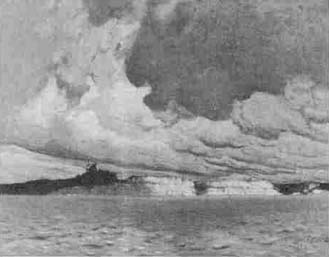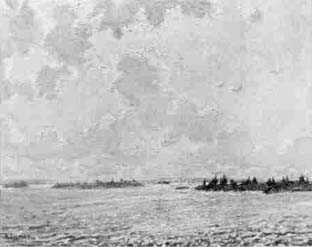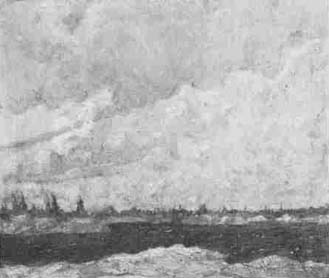
Bulletin 9-10 (V:1-2), 1967
Home
Français
Introduction
History
Annual Index
Author &
Subject
Credits
Contact



Georgian
Bay and the Development
of the September Gale Theme in
Arthur Lismer's Painting, 1912-21
by Barry Lord, Associate Fellow, Dept. of Communications Conestoga
College, Kitchener
Pages 1 | 2
| 3 | 4 |
5
| 6
From York Mills (plate 3), probably painted in the early
spring of 1913, until his 1916 pictures of his garden at Thornhill
and his removal that year to Halifax, Lismer's landscapes appear to
have been exclusively Georgian Bay or Algonquin Park scenes. These
works reflect not only his own appreciation of those regions but
also, as has been well chronicled, that of his companions. The
genesis of the national school in these early years was a group phenomenon in the best sense, with each
individual finding his own
solutions to his own painter's problems, while profiting from the
encouragement and solidarity of feeling of others working in
parallel directions. Thomson's brilliant use of colour undoubtedly
confirmed Lismer's growing chromatic range, and Jackson's The
Edge of the Maple Wood (14) exhibited in 1911, directed the
attention of Lismer and the others consciously to Canadian landscape
as a subject and indicated the possibility of discovering a
technique appropriate to it. J. E. H. MacDonald's 1913 canvas The
Lonely North (plate 4), (15) with its concentration on sunlight and
the movement of clouds and water at Go Home Lake, was almost certainly
a seminal work for Lismer's development of the theme.
Very close to the MacDonald painting in concept and execution is the
earliest known treatment of our subject by Lismer, the 1913 canvas
entitled simply Georgian Bay (plate 5), presented to the
National Gallery of Canada by the artist in 1955. (16) The composition
has obvious affinities to that of York Mills (plate 3), but is
even simpler; the horizon of trees here begins to take on the
silhouette character which soon becomes distinctive. (17) The artist's
chief interest, like MacDonald's, is in the drama of sunlight broken
by grey clouds and shimmering over the bay; his problem, as yet
unresolved, is what may be described as a rhetorical approach to
this drama. The pulsating rays stream from a central source, baffled by clouds and reflected by waves, lending a certain life to
the whole; but there is no corresponding plastic expression for
their energy in form or colour, nor are they reconciled in
composition with the strong Left-to-right thrust of wind and waves.
The painter has found his vocabulary, but not his syntax. Comparing The
Lonely North (plate 4) with Georgian Bay (plate 5) we
sense immediately that MacDonald, Lismer's senior by 12 years, is at
this point the more mature painter.
The use of impasto in Georgian Bay (plate 5) to highlight
wave and cloud indicates Lismer's appreciation of the relevance of
thicker and more textured pigment to his concern with light and
energy. However, the lack of structural and chromatic equivalents
for these preoccupations may lead us to suspect some secondary
derivation from impressionism or quasi-impressionism at this point.
This hypothesis is strengthened by the large 1914 canvas The
Guide's Home, AIgonquin. (18) The importance of this painting has,
however, been exaggerated because of its size, subject and early
date. Seen in the context of other works of the period, it is a
unique offshoot rather than a typical early painting: it had few if
any predecessors, and no further development in Lismer's career.
Even the panel sketch for the painting (19) shows more interest in the
rough texture of the subject and in the blue sky as a colour
plane than in evanescent light-and-shadow effects. In the larger
painting the purple-blue shadows peculiar to the derivative North
American impressionists of the late nineteenth and early twentieth
centuries, the attempt to capture the atmosphere of the moment, and
the choice of subject all contribute to the general
'impressionist' aspect.
Another painting of 1914 which looks back to the artist's sources is
Road through the Bush. (20) This canvas shows a lamentable
the atricality not uncommon in followers of Constable, and the origins
of what I have called a 'rhetorical' approach to light are found in
this cliché composition and treatment of the sun breaking into a
clearing where horses and loggers are staged between trees that are
virtually curtain, wings and backdrop. The upper-left source of
light is conventionally echoed in the reflections on the
leaves, lower right, while the coloration is the standard autumn
palette.
These exceptions aside, the Algonquin Park works parallel Lismer's
development in the Georgian Bay paintings. A swirling cloud
mass and a horizon of trees in silhouette are seen in a 1913 panel
in the Art Gallery of Ontario; (21) in a 1914 work also in that
collection, a panel entitled Lake in Autumn, (22) the
foreground trees are used as vertical bonds for the horizontal
layers
of foreshore, lake, distant shore and sky, in a manner only slightly
more adventurous (due to a more open com- position) than The
Banks of the Don (plate 2). In Lake in Autumn also we see
a stronger and surer colour sense, with the russet-orange hills, purplish lake and green foreground
resolving the
planes of the landscape in chromatic terms better than many works
of this date.
No Georgian Bay painting from 1914 was known until the rediscovery
last year of Breezy Weather, Georgian Bay (plate 6) (23) in a
storage area of The New Brunswick Museum. The canvas is evidently a
direct development from the National Gallery's Georgian Bay (plate
5) of the previous year. The change of title is If significant, and
the general concept is markedly closer to September Gale (plate
1). Perhaps most striking is the introduction of a steeply
pitched rocky foreground which defines the artist's point of view
and relates his familiar composition of horizontal bands in
perspective to a more complex and adventurous statement of depth.
The foreshore here assumes the fundamental outline which will be
retained in September Gale (plate 1), and the vectors of the
movement of the waves are also resolved. The trees on the horizon
have taken on a more definite character, although they are not yet
actively contributing to the action of the scene. The contoured
mobile forms of the clouds recall York Mills (plate 3) of the
previous year, and the colouring appears to substantiate the
reference to 'impressionism' in this period. In the bay, however,
the strong play of blues, as in the sky of York Mills (plate
3), gives some evidence of the more daring colour dynamics to come.
These brilliant blues are extended to both sky and bay in the 1915
oil-on-cardboard sketch entitled MacCallum's Island, Georgian Bay, (24) presented to the Art Gallery of Ontario by the artist in
1951. Lismer is here beginning to sense the need for a bolder colour
range to match the energy and light he wishes to convey. Perhaps the
most radical departure, however, is the use of a vertical rock mass
in the lower left instead of the usual trees. Although this
compositional challenge is not; too successfully met, largely because
it precludes a foreground which could establish point of view, it
does show the direction of the painter's interest. The horizon
of trees is present again, and to the immediate right of the
vertical rock passage are several horizontal outcrops which could
be said to anticipate the similar forms at the left edge of September
Gale (plate 1).
Next Page | A
Westerly Gale
1 | 2
| 3 | 4 |
5
| 6
Annual Index | Author & Subject | Credits | Contact
This digital collection
was produced under contract to Canada's Digital Collections program,
Industry Canada.
"Digital
Collections Program, Copyright
© National Gallery of
Canada 2001"